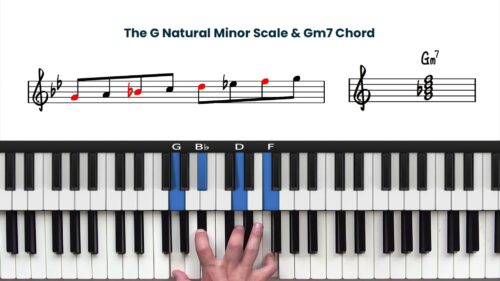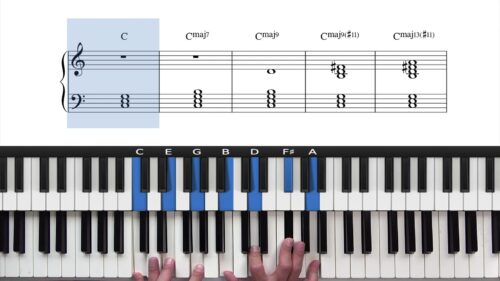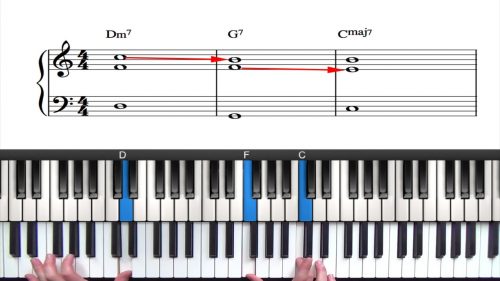“My Foolish Heart” For Beginners
For the first lesson in this module we focus on the A section of “My Foolish Heart”. The A section is the first 8 bars of the song and this section repeats twice in the A-B-A-C structure of the tune.
Triads Drills & Exercises
The lesson begins by exploring the most basic of all chord voicings — triads. We play triads in our left hand and then add the melody in our right hand. Whilst this is a simple starting point, clearly visualising the foundations of the harmony will help when moving onto more complex chord structures.
7th Chord Drills & Exercises
We then introduce 7th chords by extending each triad up to the 7th note and we play these chords in root position for the entire A section. We identify that root position 7th chords can be problematic when arranging jazz standards as there are large jumps in our left hand. The root position 7th chords can also interfere with the melody line which leads us onto the concept of “2-handed spread voicings”.
2-Handed Spread Voicings
To transform the basic triads and 7th chords into a simple but beautiful jazz piano arrangement, we must voice the notes of the chords over two hands.
This technique, known as “2-handed spread voicings” or “3-note spread voicings”, is essential for achieving balanced, smooth, and free-flowing harmony which is characteristic of jazz music.
We spend time to break down each chord and distribute the notes over 2 hands. The golden rule to remember is: ‘melody in the right hand pinky, root note in the left hand pinky, and the 3rd and 7th somewhere in between played with either hand’.
Practice Tips
-
Master Triads & 7th Chords: Begin by isolating the triads and 7th chords in your left hand. Whilst this doesn't sound like a jazz arrangement, it will help you to memorise these important chord shapes.
-
Spread Voicing Formula: Practice spreading the notes of the chords over two hands. The formula is: melody in the right hand pinky, root note in the left hand pinky, and the 3rd and 7th somewhere in between played with either hand
-
Smooth Voice Leading: Pay special attention to how the 7ths fall to 3rds in 25 and 251 progressions. This subtle movement is key to achieving a smooth sound when playing jazz piano.
-
Jazz Foundations Theory: If you find yourself struggling with these concepts, review the theory lessons in our jazz piano foundations course on triads, 7th chords, and the 251 progression. See the related lessons above.







Hi Hayden,
I keep running into an issue on bar 5 of this song (My Foolish Heart). Since there is a D7 on the third beat of the measure my ear has that F# from the harmony stuck in my head. I end up altering the melody to F# (beat 4 – 1st eighth note) to match what I hear in the harmony. Do you ever hove this issue? Is the F natural melody note there just a quick passing tone, or is it a #9 in relation to the harmony? The melody sounds like a D major triad arpeggio to me, so my ear pulls to the F#.
Hi Ray,
Great question!
Firstly, there are no ‘set-in-stone’ changes for jazz standards and so we often find many variations.
You are correct that the note “F” would be the #9 of D7 – which I like the sound of – but I wouldn’t hang around on that note too long. It just adds a little tension which aids and strengthens the movement to the G-7 – as D7 is the V7 of G. We can look at the D7 as a passing chord.
We could completely omit the D7 and just play Bbmaj7 for the whole of bar 5, I like to arpeggiate the chord tones in my right hand to fill the space. That’s one option to experiment with.
An alternative is to play bar 5 as D-7, because D-7 shares most of its tones with Bbmaj7. This also makes sense because we have E-7 to A7 in the bar 4 which creates a whole minor 251 progression moving us into bar 5. Again I would arpeggiate the chord tones of D-7 to fill the space if I am playing D-7 for the whole bar.
But yes avoid playing F# as the melody, because it is not the original melody. Perhaps you could make it work, but I feel that the options above are a better solution.
Let me know if I can help further and enjoy the lessons.
Best,
Hayden